Stock Market Patiently Waiting for Mean Reversion
Stock-Markets / Stock Markets 2014 Sep 15, 2014 - 06:20 PM GMTBy: Frank_Holmes
 So far this year, small-cap growth stocks have surprisingly been lackluster. After 2013, when it gained a scorching 38.8 percent, the Russell 2000 has delivered a tepid 0.62 percent year-to-date (YTD).
So far this year, small-cap growth stocks have surprisingly been lackluster. After 2013, when it gained a scorching 38.8 percent, the Russell 2000 has delivered a tepid 0.62 percent year-to-date (YTD).
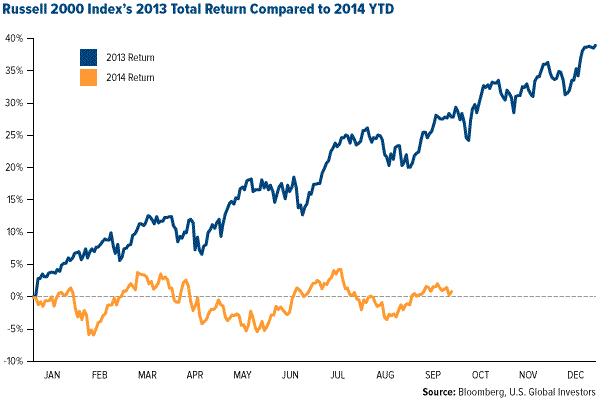
Performance has been so poor, in fact, that the spread, or bifurcation, between the 12-month return residuals of small and large caps is at its widest since the dotcom bubble of the late 1990s and early 2000s. This bifurcation is one of the largest since 1975.
According to Morgan Stanley, we’re in the worst beta-adjusted period for small-cap stocks since the late 1990s. The 12-month return in August for small-caps was -9.7 percent, placing it in the bottom 6 percent of any 12-month period since the mid-1970s.
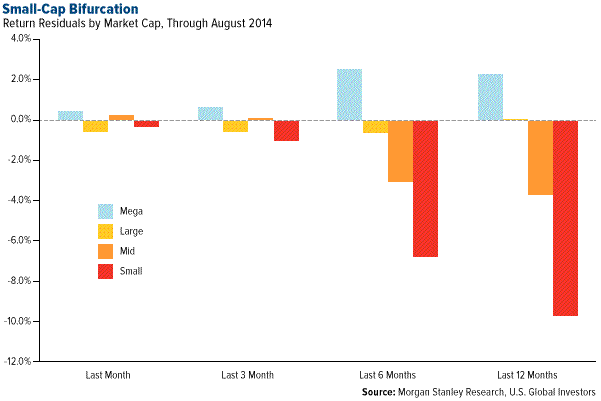
The bifurcation is more than apparent when you compare the year-to-date (YTD) total returns of the big boys (those in the S&P 500 Index and Dow Jones Industrial Average) to their little brothers (those in the Russell 2000 and S&P SmallCap 600 Index). The Russell, though it led the other indices in March, has failed to reach a new record high, which the S&P 500 and Dow managed to achieve in the last couple of months.
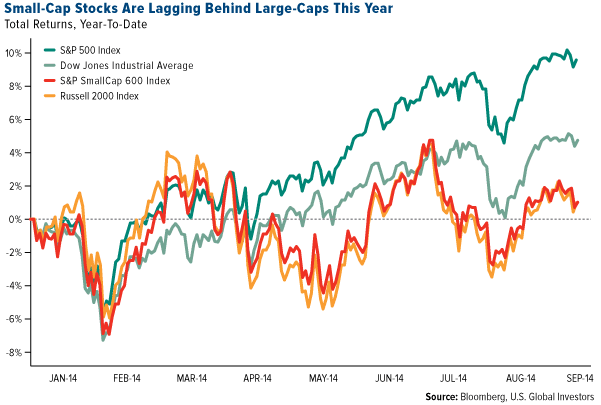
Are We on the Verge of Another Bubble?
We don’t think so. History shows bubbles are associated with excessive leverage and lofty valuations. That is not the case this time.
In July, Federal Reserve Chairwoman Janet Yellen stated in her semiannual report to Congress that small caps appear to be “substantially stretched,” even after a drop in equity prices at the beginning of the year.
There may be some truth to Yellen’s remark, an ideological echo of former Fed Chairman Alan Greenspan’s now-famous “irrational exuberance,” his description of investors’ rosy attitude toward dotcom startups of the late 1990s and early 2000s.
Much of the valuation gap has evaporated. Looking at the price/earnings to growth ratio—20x for the Russell 2000 and 18x for the S&P 500—small caps have slightly higher yet reasonable multiples and may offer better long-term growth prospects.
Mean Reversion to the Rescue
The recent underperformance among small caps has been a headwind for a few of our funds, most notably our Holmes Macro Trends Fund (MEGAX), whose benchmark, the S&P 1500 Composite, tracks the performance of not just large- and mid-cap U.S. companies, but small-cap as well. With a bias toward small-cap companies, the fund has underperformed compared to last year, when such stocks were doing well.
Because small caps tend to have higher beta than blue chips, you would expect them to outperform in a generally rising market—which we’re currently in. So it appears that a major rotation out of these riskier, more volatile stocks has inexplicably occurred, leading to the wide bifurcation between small and large companies.
The good news is that, based on 20 years of historical data, stocks in the Russell 2000 tend to rally in the fourth quarter and continue steadily until around the end of the first quarter. Over this 20-year period ending in December 2013, the Russell has generated an impressive annualized return of approximately 10 percent.
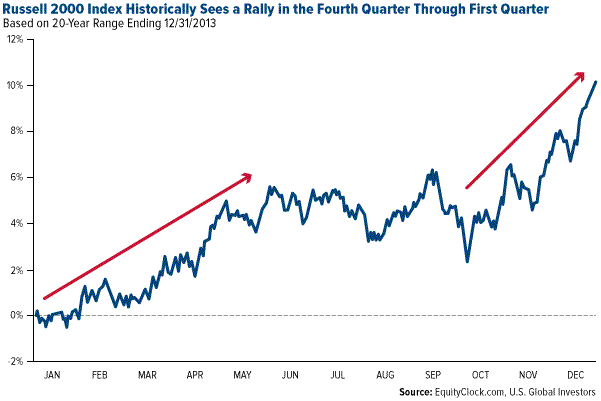
Whether or not this fourth-through-first-quarter rally will recur in 2014 and early 2015 is impossible to forecast. What can be said, however, is that prices and returns do tend to revert back to their mean over time.
I discussed this concept in full last month in the second part of my “Managing Expectations” series, “The Importance of Oscillators, Standard Deviation and Mean Reversion.” Although small caps are underperforming right now, the concept of mean reversion suggests that they’ll return to their historical relationship with large caps eventually—just as they did following the dotcom bubble.
In his 2006 book The New Rules for Investing Now: Smart Portfolios for the Next Fifteen Years, investor James P. O’Shaughnessy makes the case that small stocks have a performance advantage over large stocks simply because, well, they’re small. This might sound like circular logic, but as he writes:
“A company with $200 million in revenues is far more likely to be able to double those revenues than a company with $200 billion in revenues. With large companies, each increase in revenues becomes a smaller and smaller percentage of overall revenues. Small stocks, on the other hand, have a much easier time delivering great percentage growth in revenues and earnings.”
O’Shaughnessy examined every 20-year rolling time period beginning each month between June 1947 and December 2004. That’s 691 20-year rolling time periods. What he found is that “small stocks outperformed the S&P 500 84 percent of the time.”
If O’Shaughnessy’s research is accurate, it seems very reasonable to be optimistic in the long term. It would be myopic to look only at the Russell 2000’s recent underperformance and impulsively rotate out of small caps without also considering the decades’ worth of data showing the growth that can be achieved.
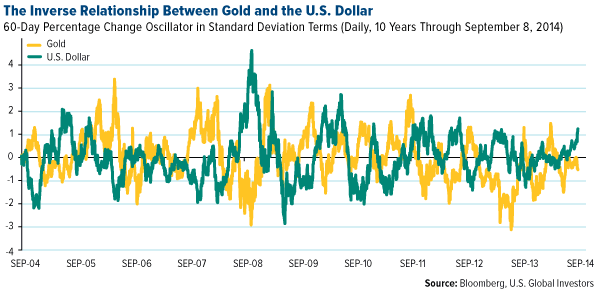
Why It’s Important to Have Your Funds Actively Managed
Comparing index funds to actively managed funds, Kiplinger columnist Steven Goldberg wrote last month: “[I]ndex funds are designed to give you all the upside of bull markets and every bit of the downside of bear markets. Only good actively managed funds can protect you from some of the pain of a bear market.”
We at U.S. Global Investors agree with Goldberg’s attitude toward good active management. Although MEGAX might be temporarily underperforming right now as a result of the sentiment-driven and disappointing performance of small-cap stocks, we’re confident that they will eventually revert back to their historical pattern as fear over Fed tightening settles down and fundamentals prevail.
In the meantime, we will continue to apply our dynamic management strategy of picking stocks in the fund using the 10-20-20 model: we focus on companies that are growing revenues at 10 percent and generating a 20 percent growth rate and 20 percent return-on-equity. This approach has served us very well in the past and enabled us to select the most attractive growth-oriented companies for our clients.
_____________________________________________________________________________________
A Note on the Strong U.S. Dollar and Gold
As I explained in a recent Frank Talk, a strong U.S. dollar could spell trouble for commodities such as gold, which tend to have a historic inverse relationship to the dollar.
When the dollar does well, investors often choose to store their money in paper rather than bars. Though September is statistically the best month for gold, with the dollar rising almost two standard deviations above its mean, this month might not be kind to the yellow metal and other commodities.
Want to receive more commentaries like this one? Sign up to receive email updates from Frank Holmes and the rest of the U.S. Global Investors team, follow us on Twitter or like us on Facebook.
By Frank Holmes
CEO and Chief Investment Officer
U.S. Global Investors
U.S. Global Investors, Inc. is an investment management firm specializing in gold, natural resources, emerging markets and global infrastructure opportunities around the world. The company, headquartered in San Antonio, Texas, manages 13 no-load mutual funds in the U.S. Global Investors fund family, as well as funds for international clients.
All opinions expressed and data provided are subject to change without notice. Some of these opinions may not be appropriate to every investor.Standard deviation is a measure of the dispersion of a set of data from its mean. The more spread apart the data, the higher the deviation. Standard deviation is also known as historical volatility. All opinions expressed and data provided are subject to change without notice. Some of these opinions may not be appropriate to every investor. The S&P 500 Stock Index is a widely recognized capitalization-weighted index of 500 common stock prices in U.S. companies. The NYSE Arca Gold BUGS (Basket of Unhedged Gold Stocks) Index (HUI) is a modified equal dollar weighted index of companies involved in gold mining. The HUI Index was designed to provide significant exposure to near term movements in gold prices by including companies that do not hedge their gold production beyond 1.5 years. The MSCI Emerging Markets Index is a free float-adjusted market capitalization index that is designed to measure equity market performance in the global emerging markets. The U.S. Trade Weighted Dollar Index provides a general indication of the international value of the U.S. dollar.
Frank Holmes Archive |
© 2005-2022 http://www.MarketOracle.co.uk - The Market Oracle is a FREE Daily Financial Markets Analysis & Forecasting online publication.



